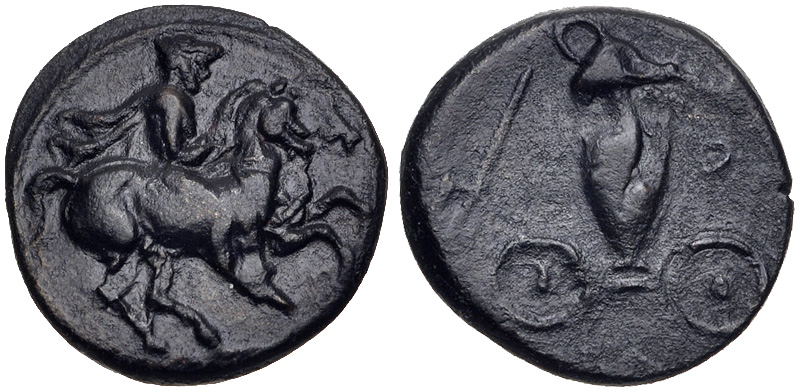SO 499 - Crannon over Crannon
From SILVER
350 BCE - 300 BCE
Location/history
| Sale(s)Sale(s) ᵖ: | Classical Numismatic Group, EA 439, 06 March 2019, n° 31. | |
Overstriking coin
Description
| ObverseInscription or printing placed on the obverse.: | Thessalian horseman galloping right, waring chlamys and petasus. Linear border. | ReverseInscription or printing placed on the reverse.: | Hydria on wheeled carriage on one of which. |
Mint and issuing power
| MintIdentifies the place of manufacture or issue of a numismatic object.: | Crannon | Ancient regionAncient region. | Thessaly | Modern countryModern country: Greece | AuthorityIdentifies the issuing power. The authority can be "pretended" when the name or the portrait of X is on the coin but he/she was not the issuing power. It can also be "uncertain" when there is no mention of X on the coin but he/she was the issuing power according to the historical sources: |
Chronology
| FromIdentifies the initial date in a range assigned in a numismatic context. 350 BCE toIdentifies the final date in a range assigned in a numismatic context.. 300 BCE | Classical and Hellenistic periodTime period of the numismatic object. |
Physical description
| MetalThe physical material (usually metal) from which an object is made.: Bronze |
WeightWeight of the numismatic object (in grams). in grams: 2.532.53 g <br />2,530 mg <br /> | DenominationTerm indicating the value of a numismatic object. Examples: tetradrachm, chalkous, denarius.: dichalkon |
AxisDescribes the directional relationship between the obverse and reverse of a numismatic object.: 88 mm <br />0.8 cm <br /> |
| DiameterDescribes diameter of an object (in mm).: 1515 mm <br />1.5 cm <br /> | |||
References
| Coin referenceReference of the Coin: | Coin series referenceReference to coin series study: | Edgar Rogers 19321Edgar Rogers 1932, n° 191-201, BCD Thessaly II2BCD Thessaly II, n° 119.2, HGC 43HGC 4, n° 385-386 var. | |
| Coin series web referenceCoin series web references: | |||
Overstruck type
Description
| ObverseInscription or printing placed on the obverse.: | Thessalian horseman galloping right, waring chlamys and petasus (visible on obverse). | ReverseInscription or printing placed on the reverse.: | KPAN (Greek) Bull charging right. Above, trident (visible on reverse: back part of bull and trident). |
Mint and issuing power
| MintIdentifies the place of manufacture or issue of a numismatic object. ᵖ: | Crannon | Ancient regionAncient region. ᵖ | Thessaly | Modern countryModern country: Greece | AuthorityIdentifies the authority in whose name (explicitly or implicitly) a numismatic object was issued. ᵖ: |
Chronology
| FromIdentifies the initial date in a range assigned in a numismatic context. 350 BCE toIdentifies the final date in a range assigned in a numismatic context.. 300 BCE | Classical 480-323 BC |
Physical description
References
| Coin type referenceReference to coin series study ᵖ: | HGC 43HGC 4, n° 391-392, Edgar Rogers 19321Edgar Rogers 1932, n° 187-90. | ||
| Coin series web reference overstruckCoin series web references overstruck: | |||
Additional data
| Frequency of overstrikesFrequency of overstrikes: | Level of confidenceLevel of confidence of the identification: | ||
| RemarksRemarks: | "Overstruck on a contemporary chalkous issue (cf. HGC 4, 392)" | ||

